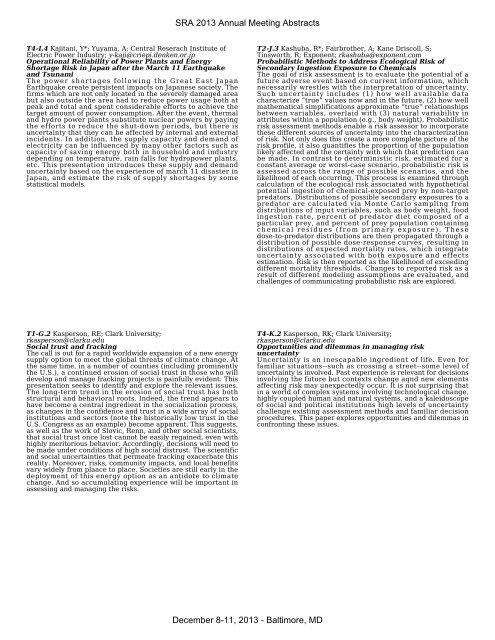Abstracts (PDF file, 1.8MB) - Society for Risk Analysis
Abstracts (PDF file, 1.8MB) - Society for Risk Analysis
Abstracts (PDF file, 1.8MB) - Society for Risk Analysis
Create successful ePaper yourself
Turn your PDF publications into a flip-book with our unique Google optimized e-Paper software.
SRA 2013 Annual Meeting <strong>Abstracts</strong><br />
T4-I.4 Kajitani, Y*; Yuyama, A; Central Reserach Institute of<br />
Electric Power Industry; y-kaji@criepi.denken.or.jp<br />
Operational Reliability of Power Plants and Energy<br />
Shortage <strong>Risk</strong> in Japan after the March 11 Earthquake<br />
and Tsunami<br />
The power shortages following the Great East Japan<br />
Earthquake create persistent impacts on Japanese society. The<br />
firms which are not only located in the severely damaged area<br />
but also outside the area had to reduce power usage both at<br />
peak and total and spent considerable ef<strong>for</strong>ts to achieve the<br />
target amount of power consumption. After the event, thermal<br />
and hydro power plants substitute nuclear powers by paying<br />
the ef<strong>for</strong>ts to reduce the shut-down periods, but there is<br />
uncertainty that they can be affected by internal and external<br />
incidents. In addition, the supply capacity and demand of<br />
electricity can be influenced by many other factors such as<br />
capacity of saving energy both in household and industry<br />
depending on temperature, rain falls <strong>for</strong> hydropower plants,<br />
etc. This presentation introduces these supply and demand<br />
uncertainty based on the experience of march 11 disaster in<br />
Japan, and estimate the risk of supply shortages by some<br />
statistical models.<br />
T2-J.3 Kashuba, R*; Fairbrother, A; Kane Driscoll, S;<br />
Tinsworth, R; Exponent; rkashuba@exponent.com<br />
Probabilistic Methods to Address Ecological <strong>Risk</strong> of<br />
Secondary Ingestion Exposure to Chemicals<br />
The goal of risk assessment is to evaluate the potential of a<br />
future adverse event based on current in<strong>for</strong>mation, which<br />
necessarily wrestles with the interpretation of uncertainty.<br />
Such uncertainty includes (1) how well available data<br />
characterize “true” values now and in the future, (2) how well<br />
mathematical simplifications approximate “true” relationships<br />
between variables, overlaid with (3) natural variability in<br />
attributes within a population (e.g., body weight). Probabilistic<br />
risk assessment methods enable a risk assessor to incorporate<br />
these different sources of uncertainty into the characterization<br />
of risk. Not only does this create a more complete picture of the<br />
risk pro<strong>file</strong>, it also quantifies the proportion of the population<br />
likely affected and the certainty with which that prediction can<br />
be made. In contrast to deterministic risk, estimated <strong>for</strong> a<br />
constant average or worst-case scenario, probabilistic risk is<br />
assessed across the range of possible scenarios, and the<br />
likelihood of each occurring. This process is examined through<br />
calculation of the ecological risk associated with hypothetical<br />
potential ingestion of chemical-exposed prey by non-target<br />
predators. Distributions of possible secondary exposures to a<br />
predator are calculated via Monte Carlo sampling from<br />
distributions of input variables, such as body weight, food<br />
ingestion rate, percent of predator diet composed of a<br />
particular prey, and percent of prey population containing<br />
chemical residues (from primary exposure). These<br />
dose-to-predator distributions are then propagated through a<br />
distribution of possible dose-response curves, resulting in<br />
distributions of expected mortality rates, which integrate<br />
uncertainty associated with both exposure and effects<br />
estimation. <strong>Risk</strong> is then reported as the likelihood of exceeding<br />
different mortality thresholds. Changes to reported risk as a<br />
result of different modeling assumptions are evaluated, and<br />
challenges of communicating probabilistic risk are explored.<br />
T1-G.2 Kasperson, RE; Clark University;<br />
rkasperson@clarku.edu<br />
Social trust and fracking<br />
The call is out <strong>for</strong> a rapid worldwide expansion of a new energy<br />
supply option to meet the global threats of climate change. At<br />
the same time, in a number of counties (including prominently<br />
the U.S.), a continued erosion of social trust in those who will<br />
develop and manage fracking projects is painfully evident. This<br />
presentation seeks to identify and explore the relevant issues.<br />
The long-term trend in the erosion of social trust has both<br />
structural and behavioral roots. Indeed, the trend appears to<br />
have become a central ingredient in the socialization process,<br />
as changes in the confidence and trust in a wide array of social<br />
institutions and sectors (note the historically low trust in the<br />
U.S. Congress as an example) become apparent. This suggests,<br />
as well as the work of Slovic, Renn, and other social scientists,<br />
that social trust once lost cannot be easily regained, even with<br />
highly meritorious behavior. Accordingly, decisions will need to<br />
be made under conditions of high social distrust. The scientific<br />
and social uncertainties that permeate fracking exacerbate this<br />
reality. Moreover, risks, community impacts, and local benefits<br />
vary widely from plaace to place. Societies are still early in the<br />
deployment of this energy option as an antidote to climate<br />
change. And so accumulating experience will be important in<br />
assessing and managing the risks.<br />
T4-K.2 Kasperson, RK; Clark University;<br />
rkasperson@clarku.edu<br />
Opportunities and dilemmas in managing risk<br />
uncertainty<br />
Uncertainty is an inescapable ingredient of life. Even <strong>for</strong><br />
familiar situations--such as crossing a street--some level of<br />
uncertainty is involved. Past experience is relevant <strong>for</strong> decisions<br />
involving the future but contexts change aqnd new elements<br />
affecting risk may unexpectedly occur. It is not surprising that<br />
in a world of complex systems involving technological change,<br />
highly coupled human and natural systems, and a kaleidoscope<br />
of social and political institutions high levels of uncertainty<br />
challenge existing assessment methods and familiar decision<br />
procedures. This paper explores opportunities and dilemmas in<br />
confronting these issues.<br />
December 8-11, 2013 - Baltimore, MD
















